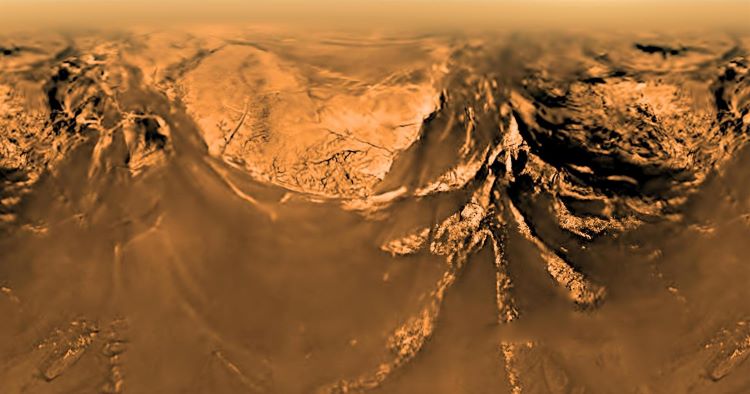Does Saturn’s largest moon, Titan, possess the necessary ingredients for life to exist? This is what a recent study published in Astrobiology hopes to address as a team of international researchers led by Western University investigated if Titan, with its lakes of liquid methane and ethane, could possess the necessary organic materials, such as amino acids, that could be used to produce life on the small moon. This study holds the potential to help researchers and the public better understand the geochemical and biological processes necessary for life to emerge throughout the cosmos.
Along with its liquid lakes of methane and ethane, Titan is also strongly hypothesized to possess a subsurface liquid water ocean like Saturn’s icy moon, Enceladus, and Jupiter’s icy moon, Europa. For the study, the researchers used data from impact cratering from comets to estimate the number of organic molecules that could relocate from Titan’s surface to its subsurface liquid water ocean. The team hypothesized that when comets strike Titan’s surface, their icy materials would melt from the heat of the impact and mix with the surface organics, resulting in a unique mixture. However, the heavier liquid water would then sink to the subsurface, slowly filling the subsurface ocean over time.

After accounting for a presumed annual number of cometary impacts on Titan’s surface throughout its billions of years of existence, the researchers then calculated how much water would make its way from the surface to the subsurface ocean. In the end, the team concluded that the amount of glycine, which is the most basic amino acid that forms the proteins to create life, was measured at no greater than 7,500 kilograms/year (16,530 pounds/year). This amount approximately equals the size of a smaller African forest elephant, hence indicating number of organic materials that exist on Titan is quite miniscule.
“One elephant per year of glycine into an ocean 12 times the volume of Earth’s oceans is not sufficient to sustain life,” said Dr. Catherine Neish, who is an associate professor in the Department of Earth Sciences at Western University and lead author of the study. “In the past, people often assumed that water equals life, but they neglected the fact that life needs other elements, in particular carbon.”
While Dr. Neish’s study presents somewhat dire implications for finding life on Titan, this study comes on the heels of a recent investigation into how organic hazes on ancient Earth could have contained the necessary building blocks of life, including nucleobases and amino acids, which could hold implications for finding life on Titan due to the moon’s hazy atmosphere. For this study, the researchers used laboratory experiments to determine that “warm little ponds” on ancient Earth could host nucleobases. Both studies offer profound insights into the processes responsible for both creating and sustaining life beyond Earth, and further research is undoubtedly required to better understand these processes.
One such research opportunity that could help solidify these studies could be NASA’s upcoming Dragonfly mission, which is a quadcopter designed to search Titan’s surface for signs of potential habitability with Dr. Neish assigned as a mission co-investigator. Dragonfly currently has a scheduled launch date of July 2028, arriving at Saturn’s largest moon sometime in 2034. While Dragonfly will not be the first aircraft on another world, as that honor goes to NASA’s Ingenuity Mars Helicopter, it will be the first aircraft to land and operate in the outer solar system. Dragonfly will launch more than 20 years after the European Space Agency’s Huygens probe landed on Titan in January 2005, beaming back images of rounded rocks that could have formed from liquid processes.
What new discoveries will scientists make about Titan and its potential for life in the coming years and decades? Only time will tell, and this is why we science!
As always, keep doing science & keep looking up!


“In the past, people often assumed that water equals life, but they neglected the fact that life needs other elements, in particular carbon.”
For terrestrial surface and crust water, yes. But it seems an odd claim for ice or water world oceans, where bottom ices has long been considering a constraint on nutrient availability. Titan is believed to be an example of an ice-locked ocean. NASA:
“Titan’s internal structure isn’t entirely known, but one model based on data from the Cassini-Huygens mission suggests Titan has five primary layers. The innermost layer is a core of rock (specifically, water-bearing silicate rock) about 2,500 miles (4,000 kilometers) in diameter. Surrounding the core is a shell of water ice—a special type called ice-VI that is only found at extremely high-pressures. The high-pressure ice is surrounded by a layer of salty liquid water, on top of which sits an outer crust of water ice.”